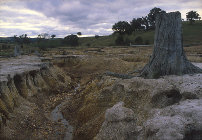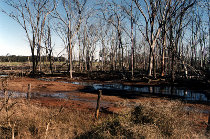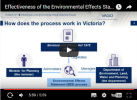
Almost half of Australia's terrestrial ecosystems are threatened, 85 per cent of its rivers have been modified and twice as many Australians die from air pollution annually than road accidents, according to a report on the state of the country's environment.
42 environmental growth have cooperated to bring us this damning report, and hopefully will be a wake-up call that we are living beyond our means, and must change.
SMH: Australia's environment is going backwards
Places you Love . One cannot ignore the irony of the title of the report, that we "love" these unique Australian places, that many of us hold dear to us from childhood, holidays and where we live, but also destroy with wanton cruelty and reckless haste.
The introduction to this report states that:
More than 85% of rivers in Australia have been modified due to irrigation, dams other development pressures.
Of the sixty-eight zones of the Murray-Darling Basin, Australia’s most significant agricultural region, only one zone is rated in good health. Thirty-eight zones are rated in poor health and twenty-one in very poor health.
Ongoing impacts of development and disturbance and the projected impacts of climate change will result in further decline of freshwater resources. Almost one-third of the 851 nationally important wetlands in Australia do not have adequate water supply or flow to maintain their health.
It's an abysmal state of affairs, similar to the wreckage and mess left by the punters and party-goers after Melbourne Cup day at Flemington!
The party is over, and there's few people cleaning up the "mess" of environmental devastation!
Places You Love is landmark survey of Australia’s environment – our rivers, energy, climate, food, forests, waste and pollution, land management, oceans and reefs.
Climate change
We will likely see four degrees of warming by the end of this century.
Two degrees of climate warming will likely mean the loss of most coral cover on the Great Barrier Reef, 80% of freshwater wetlands from Kakadu National Park, and Queensland’s tropical forests.
Air Pollution
More than 3,000 Australians die each year from air-pollution-related illness, nearly twice the national road toll.
Each Australian family contributes enough rubbish each year to fill a three-bedroom house from floor to ceiling, and the total amount of waste generated in the future is projected to increase.
Oceans
Since 1985 more than half of the coral cover of the Great Barrier Reef has been lost. Remaining coral cover is predicted to be lost with two degrees warming through climate change. Ocean acidification, a consequence of rising anthropogenic CO2 emissions, is poised to change marine ecosystems profoundly by increasing dissolved CO2 and decreasing ocean pH, carbonate ion concentration, and calcium carbonate mineral saturation state worldwide.
Feral animals and plants
Invasive species have significantly contributed to extinctions in most regions of Australia,including more than 40 native mammals, birds and frogs.
Habitat Change
We cleared an average of 1 million hectares of native vegetation per year between 2000 and 2010. At least 50% of all wetlands in Australia have been drained, filled or destroyed.
1259 plants, 396 animals and 67 ecological communities are listed as threatened by the Australian Government.
Destruction and fragmentation of habitats are major factors in the global decline of species, the modification of native plant and animal communities and the alteration of ecosystem functions. We are a leading nation when it comes to extinction, and our unique species that have had millions of years to adapt to our fragile existence on a variable and harsh landscape are being wiped out in record levels.

(image: CSIRO - soil erosion)
Forests
Of an original 235 million hectares of Australia’s forests and woodlands, 44% or about 104 million hectares have been cleared since European settlement. 36% was cleared before 1972 and 5% after 1972 – representing 85.7 million and 11.5 million hectares respectively
The clearing has been offset by the regrowth of 2.9% of the original cleared area.
In the absence of clearing, forest and woodland losses are presumed to be due to causes such as fire, drought or disease like die-back. Non-clearing losses have accounted for 5% of the area changed in the last 20 years.
Of the 50.5% of forests and woodlands that have not been cleared or lost due to non-clearing events, 20.5% were converted to non-forest at some point after 1972 and are therefore in disturbed condition.
Humans in Australia
By 2100, Australian population is projected to be between 42 and 70 million people. Total consumption per person in Australia is one of the highest in the world, and is projected to increase by up to 27% by 2030, with far-reaching impacts on nature including biodiversity, land use, climate and water.
By 2050, energy consumption in Australia is projected to increase by around 21%, with only 14% coming from renewable sources.
As you read through the data you will see our natural world is struggling to sustain itself. Nature is in decline and the natural beauty of Australia is under threat.
Firstly, in Australia we have neither a comprehensive picture of the health of nature, nor a complete understanding of the impacts of any decline in nature on our own wellbeing. We may be intellectually and technologically the most "advanced" and highly evolved species on the planet, but we must be the most retarded species when it comes to being aware of our own impacts on our life-supporting habitats for ourselves, and other species in our ecosystems.
Second, our institutions, globally and in Australia, are not optimized to address the increasingly complex and and the importance of adopting broader definitions of integrated challenges arising at the interface of social, sustainable wellbeing as a frame for effectively valuing
economic, technological and environmental concerns5. and protecting nature.
Human intellect remains myopic and shallow when it comes to the health of the environment, and our own spaceship Earth! Our governments' and institutions' tunnel-vision, based on short-term greed and economic benefits rather than long term strategies for living sustainably, and within Nature's limits.
Third, our understanding and definition of human wellbeing may be far too narrow. Some people and groups may be doing extraordinary things for nature, inspiring us all to better value and protect what we have, but they remain voices in the wilderness, on the peripheral, not in the mainstream. Animal species may impact on their environment, but not so that it can't spring back and recover! Humans, on the other hand, seem to incapable of limiting their desire to take more than they can, and it's justified by "economic growth", greed, traditions and culture!
Finally, the term ‘sustainability’ is used far too loosely in regard to humanity’s impact on nature. Depending on the context, it is often not measured, is poor. The word is too subjective, vague, and has been over-used and has become an oxymoron. The word has been stuck on almost any implementation or institution, including human growth, and thus a contradiction!
Population growth
"The most influential driving forces on nature are population growth and developments in the needs and activities of individuals, as expressed through material extraction and consumption. Population is projected to grow up to 42-70 million by 2100.”
So, our dying ecosystems, and diminishing natural resources, will be deliberately further stretched by governments tweaking our population growth through high and unsustainable rates of immigration! It expecting a moribund body, in the throes of death, forced to keep breaking stones and climb mountains!
Our population is projected to increase to between 36.8 million and 48.3 million in 2061, and reach between 42.4 million and 70.1 million in 2101 (Figure 3)33. The projected development of infrastructure (e.g. housing, transport, water supply, energy, communications) strongly correlates with anticipated population growth, reflecting the longstanding pattern of association among these variables. Of course, the report does not mention that our population growth is not due to natural growth, of births over deaths, but due to a bipartisan policy of "big Australia", high rates of net overseas immigration, and housing - a major industry in Australia!
To add to the slow death of our environment, the pain will be exacerbated by Australia consuming more resources per person than most
other nations on Earth. We consume about 35 tonnes per person per year. By contrast, an emerging nation like India consumes about 5 tonnes per person, while the US and 2.5 Japan consume about 28 tonnes.
The report concludes that while there is currently no long-term plan for the future sustainable development of Australian society, there is a growing movement of passionate and active communities across Australia, taking action to ensure their own futures.
These actions are collaborative, innovative and proactive, and gathering momentum by the day.
However, these groups passionate for change and for our nation's environment are usually sidelined, or marginalized, due to our limited democratic system, and an economic model based on capitalistic growth, and short-term gain at the cost of the welfare of future generations of all species. The "party" is over, and Australia's growth-based economy based on increasing consumerism must end - or we wreck the land that gives us food, water, sustenance, functioning ecosystems, and all that we "love" about our country!

(image: CSIRO Salinity affected land )
Glen Klatovsky – Director was National Campaigner for The Wilderness Society, leading the campaign to stop a gas hub at James Price Point. Glen was the Carbon Business Manager for Greening Australia. He was also Director, Advocacy for WWF-Australia.

 Climate change poses a real and growing risk to Victoria’s built environment says a report tabled today by the Legislative Council Environment and Planning Committee. Metropolitan Melbourne faces distinct climate change risks due to its high population density and impervious surfaces,intensifying the heat island effect.
Climate change poses a real and growing risk to Victoria’s built environment says a report tabled today by the Legislative Council Environment and Planning Committee. Metropolitan Melbourne faces distinct climate change risks due to its high population density and impervious surfaces,intensifying the heat island effect. Grassroots advocacy group, Australians for Mental Health (AfMH) is calling for urgent and significant reform following a damning assessment found the national plan to improve mental health and prevent suicide is “not fit for purpose.”
Grassroots advocacy group, Australians for Mental Health (AfMH) is calling for urgent and significant reform following a damning assessment found the national plan to improve mental health and prevent suicide is “not fit for purpose.” The crisis in Venezuela will not be solved by sanctions that “can lead to starvation”, a UN-appointed rights expert said on Thursday. Special Rapporteur
The crisis in Venezuela will not be solved by sanctions that “can lead to starvation”, a UN-appointed rights expert said on Thursday. Special Rapporteur  This is the report that Bob Carr referred to in the Q&A "A Big Australia" program on Monday 12 March, 2018. "The survey found that 74 per cent of voters thought that Australia does not need more people, with big majorities believing that that population growth was putting ‘a lot of pressure’ on hospitals, roads, affordable housing and jobs (Figure 4). Most voters were also worried about the consequences of growing ethnic diversity. Forty-eight per cent supported a partial ban on Muslim immigration to Australia, with only 25 per cent in opposition (Figure 3). Despite these demographic pressures and discontents, Australia’s political and economic elites are disdainful of them and have ignored them. They see high immigration as part of their commitment to the globalisation of Australia’s economy and society and thus it is not to be questioned. Elites elsewhere in the developed world hold similar values, but have had to retreat because of public opposition. Across Europe 15 to 20 per cent of voters currently support anti-immigration political parties. Our review of elite opinion in Australia shows that here they think they can ignore public concerns. This is because their main source of information about public opinion on the issue, the Scanlon Foundation, has consistently reported that most Australians support their immigration and cultural diversity policies." [Extract from Executive Summary, The Australian Population Research Institute (TAPRIS)]
This is the report that Bob Carr referred to in the Q&A "A Big Australia" program on Monday 12 March, 2018. "The survey found that 74 per cent of voters thought that Australia does not need more people, with big majorities believing that that population growth was putting ‘a lot of pressure’ on hospitals, roads, affordable housing and jobs (Figure 4). Most voters were also worried about the consequences of growing ethnic diversity. Forty-eight per cent supported a partial ban on Muslim immigration to Australia, with only 25 per cent in opposition (Figure 3). Despite these demographic pressures and discontents, Australia’s political and economic elites are disdainful of them and have ignored them. They see high immigration as part of their commitment to the globalisation of Australia’s economy and society and thus it is not to be questioned. Elites elsewhere in the developed world hold similar values, but have had to retreat because of public opposition. Across Europe 15 to 20 per cent of voters currently support anti-immigration political parties. Our review of elite opinion in Australia shows that here they think they can ignore public concerns. This is because their main source of information about public opinion on the issue, the Scanlon Foundation, has consistently reported that most Australians support their immigration and cultural diversity policies." [Extract from Executive Summary, The Australian Population Research Institute (TAPRIS)] Successive Victorian governments too closely aligned with property development and investment have inflicted continuous rapid population growth on Victorians. This has had a terrible effect on democratic rights to object and protect property and the environment, built and wild. It has seemed that no power could hold the government up to any effective criticism. The Victorian Auditor General has tabled the following reports. We have included an extract from the report which shows a democratic deficit in the public review process. This report may be of use to population and environment activists and they should publicise it.
Successive Victorian governments too closely aligned with property development and investment have inflicted continuous rapid population growth on Victorians. This has had a terrible effect on democratic rights to object and protect property and the environment, built and wild. It has seemed that no power could hold the government up to any effective criticism. The Victorian Auditor General has tabled the following reports. We have included an extract from the report which shows a democratic deficit in the public review process. This report may be of use to population and environment activists and they should publicise it.


Recent comments